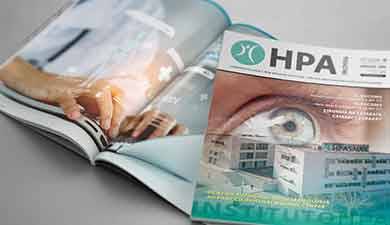Dr. Tiago Baptista
Fernandes
Plastic Surgeon
Coordinator of the UP HPA

Implant replacement
HPA Magazine 18
With the large volume of augmentation mammoplasties that have taken place in recent decades, implant replacement appears, together with augmentation mammoplasties, as one of the most sought-after procedures today. The International Society of Aesthetic Surgery (ISAPS) pre-pandemic statistics, show that there was an increase of approximately 47% in implant replacement surgery, with breast augmentation remaining the first most performed plastic surgery with a 9% increase in the period from 2016 to 2019.

Top 5 surgical procedures in women:
1. Breast Augmentation - 1,601,713
2. Liposuction - 1,300,020
3. Blepharoplasty - 968,381
4. Abdominoplasty - 703,778
5. Rhinoplasty - 643,468
(ISAPS Statistics)
The use of silicone implants has as its main goal the following indications:
• to correct congenital breast deformities, such as
tuberous breast;
• breast augmentation in women with inadequate
breast volume to attain their ideal silhouette;
• correction of breast hypoplasia
(no breasts or very small breast);
• breast reconstruction after breast cancer;
• sagging or breast ptosis.
Implant replacement is often indicated due to an increase in the thickness of the capsule around the implants (the body's natural response to isolate a foreign body) and / or due to sagging of the breast, which occurs progressively over time. Sagging or ptosis, is accentuated by:
• weight loss;
• pregnancy and breastfeeding;
• aging of the skin and breast tissue.
During the consultation, patients often express a desire to replace implants for the following reasons:
• desire to change the size of the implants;
• concerns about leakage or displacement
of the implants;
• desire to change the type or shape
of the implant;
• pain associated with contracture of the capsule.
Over the years, the original shape of the implants can become deformed, as can the tissue that covers the implants, resulting in a less desirable appearance than the original result. The risk of rupture of an implant is small, but not rare, but tissue changes and deformations lead most patients to perform implant replacement after 10 to 15 years. However, implants can last a lifetime. This information is very relevant and we pass it onto our patients for the sake of transparency, which must exist when surgical interventions are performed on healthy people who seek to improve the shape and volume of the breast, with obvious impact on self-esteem.
Most prosthetic manufacturers offer a 10-year guarantee in the event of specific problems occurring such as rupture, late seroma or contractures. The percentage of the reimbursement varies according to each case. However, polyurethane coated implants carry a lifetime guarantee against contracture.
The micro polyurethane coating allows superior adhesion to adjacent tissue, significantly reducing displacement, rotation and contracture of the capsule. It is important to clarify that the cost-free guarantee only covers the cost of the new implants, as long as the same brand is used.
In consultation, the patient is evaluated and her expectations are taken into account. A decision is made by the plastic surgeon in each specific case based on medical indication. The goal is to provide the most suitable shape to the woman's breast so the following procedures might need to be carried out concomitantly:
• mastopexy or breast reduction;
• remodelling of the implant pocket
to reposition the new implants in the chest;
• change the size (to either increase or decrease),
type of implant and/or shape;
• decrease of the breast areola
Types of surgery (in the case of post-cancer reconstruction, each breast might require a different surgery):
• total or partial removal of the capsules;
• change of implant location – altering from the
subglandular to submuscular placement,
or creating of a new submuscular pocket;
• choosing a new implant and adaptation
to the new shape and/or volume;
• removal of any excess skin;
• closure of the skin with resorbable stitches
and biological glue.
As with the other procedures performed by me and the other plastic surgeons at UP HPA, Dr David Rasteiro and Dr Rui Lima, one of the goals is to carry out a customized surgical procedure for each patient, taking into account the patient’s wishes and expectations, where a detailed and enlightening consultation is essential to align expectations and possibilities.
It is fundamental to emphasize that, despite a significant transformation in the shape of the breast being possible, in most cases the aesthetic result of the intervention is inferior to that of the initial surgery, mainly for the following reasons:
• the skin has already expanded with the first inter-
vention and does not respond in an equivalent way;
• contracture of the capsule may have left tissue
areas, less thick and with irregularities;
• the breast tissue is thinner and therefore with less coverage for the new implant.
The surgery normally lasts between 2 to 4 hours and is performed on an outpatient basis (discharge on the same day), leaving a drain that normally takes between 2 to 3 days to be removed. Resuming active life is expected between 1 and 3 weeks, depending on each clinical case and each profession.
The postoperative period is a fundamental step for the success of the intervention, and the therapist must be endowed with specific technical skills. We are pleased to inform you that throughout the Algarve and Alentejo, we have highly prepared professionals for post-operative recovery.
Thus, we have assembled a team of excellent plastic surgeons with knowhow and experience in all types of breast surgery, able to create the best surgical plan for each specific case.








